现代物流概论总结
- 格式:doc
- 大小:253.00 KB
- 文档页数:22
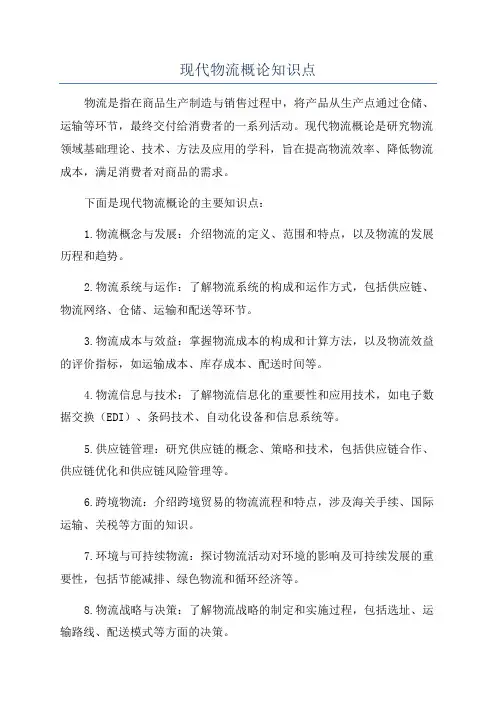
现代物流概论知识点物流是指在商品生产制造与销售过程中,将产品从生产点通过仓储、运输等环节,最终交付给消费者的一系列活动。
现代物流概论是研究物流领域基础理论、技术、方法及应用的学科,旨在提高物流效率、降低物流成本,满足消费者对商品的需求。
下面是现代物流概论的主要知识点:1.物流概念与发展:介绍物流的定义、范围和特点,以及物流的发展历程和趋势。
2.物流系统与运作:了解物流系统的构成和运作方式,包括供应链、物流网络、仓储、运输和配送等环节。
3.物流成本与效益:掌握物流成本的构成和计算方法,以及物流效益的评价指标,如运输成本、库存成本、配送时间等。
4.物流信息与技术:了解物流信息化的重要性和应用技术,如电子数据交换(EDI)、条码技术、自动化设备和信息系统等。
5.供应链管理:研究供应链的概念、策略和技术,包括供应链合作、供应链优化和供应链风险管理等。
6.跨境物流:介绍跨境贸易的物流流程和特点,涉及海关手续、国际运输、关税等方面的知识。
7.环境与可持续物流:探讨物流活动对环境的影响及可持续发展的重要性,包括节能减排、绿色物流和循环经济等。
8.物流战略与决策:了解物流战略的制定和实施过程,包括选址、运输路线、配送模式等方面的决策。
9.物流服务与客户关系:介绍物流服务的内涵与要素,以及提高客户满意度的策略和方法。
10.物流风险管理:讨论物流活动中可能出现的风险,并提供相应的应对措施,包括供应链中断、库存损失、质量问题等。
11.物流法律与法规:介绍与物流活动相关的法律法规,包括合同法、运输法、海关法等,了解相关法规对物流业务的规范要求。
以上为现代物流概论的主要知识点,通过了解这些知识,可以更好地理解物流活动的本质和运作方式,为日后的物流管理和实践提供基础。
同时,随着信息技术的发展和全球化的推进,物流领域的知识也在不断更新和演进,因此,持续学习和更新物流知识是非常重要的。
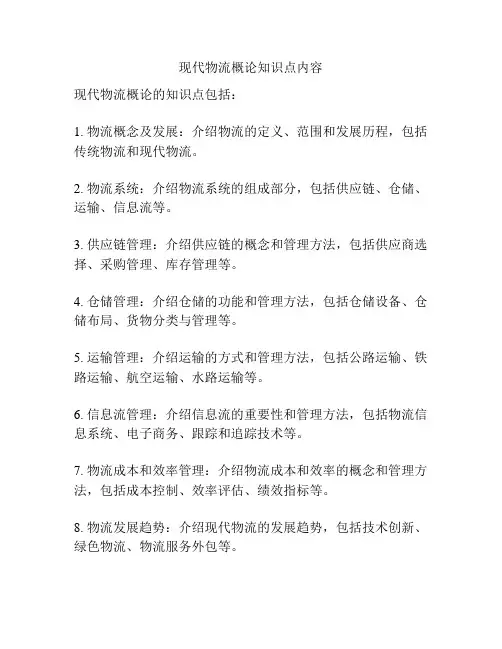
现代物流概论知识点内容
现代物流概论的知识点包括:
1. 物流概念及发展:介绍物流的定义、范围和发展历程,包括传统物流和现代物流。
2. 物流系统:介绍物流系统的组成部分,包括供应链、仓储、运输、信息流等。
3. 供应链管理:介绍供应链的概念和管理方法,包括供应商选择、采购管理、库存管理等。
4. 仓储管理:介绍仓储的功能和管理方法,包括仓储设备、仓储布局、货物分类与管理等。
5. 运输管理:介绍运输的方式和管理方法,包括公路运输、铁路运输、航空运输、水路运输等。
6. 信息流管理:介绍信息流的重要性和管理方法,包括物流信息系统、电子商务、跟踪和追踪技术等。
7. 物流成本和效率管理:介绍物流成本和效率的概念和管理方法,包括成本控制、效率评估、绩效指标等。
8. 物流发展趋势:介绍现代物流的发展趋势,包括技术创新、绿色物流、物流服务外包等。
这些知识点涵盖了现代物流概论的基本内容,有助于学习者全面了解和掌握物流管理的基本原理和实践方法。
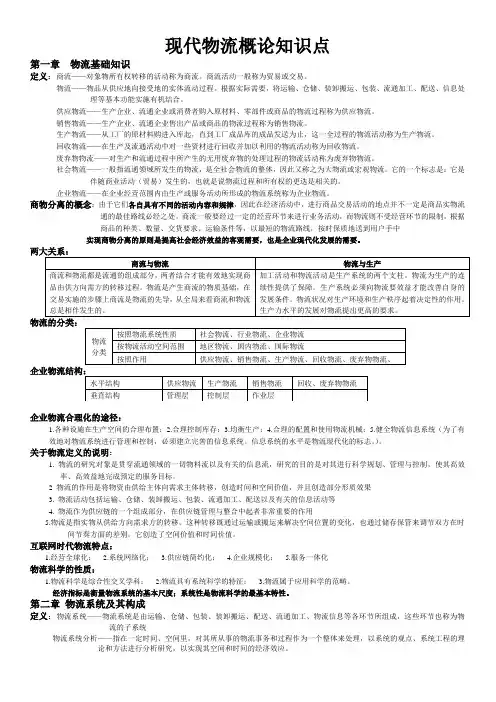
现代物流概论知识点第一章物流基础知识定义:商流——对象物所有权转移的活动称为商流。
商流活动一般称为贸易或交易。
物流——物品从供应地向接受地的实体流动过程。
根据实际需要,将运输、仓储、装卸搬运、包装、流通加工、配送、信息处理等基本功能实施有机结合。
供应物流——生产企业、流通企业或消费者购入原材料、零部件或商品的物流过程称为供应物流。
销售物流——生产企业、流通企业售出产品或商品的物流过程称为销售物流。
生产物流——从工厂的原材料购进入库起,直到工厂成品库的成品发送为止,这一全过程的物流活动称为生产物流。
回收物流——在生产及流通活动中对一些资材进行回收并加以利用的物流活动称为回收物流。
废弃物物流——对生产和流通过程中所产生的无用废弃物的处理过程的物流活动称为废弃物物流。
社会物流——一般指流通领域所发生的物流,是全社会物流的整体,因此又称之为大物流或宏观物流。
它的一个标志是:它是伴随商业活动(贸易)发生的,也就是说物流过程和所有权的更迭是相关的。
企业物流——在企业经营范围内由生产或服务活动所形成的物流系统称为企业物流。
商物分离的概念:由于它们各自具有不同的活动内容和规律,因此在经济活动中,进行商品交易活动的地点并不一定是商品实物流通的最佳路线必经之处。
商流一般要经过一定的经营环节来进行业务活动,而物流则不受经营环节的限制,根据商品的种类、数量、交货要求、运输条件等,以最短的物流路线,按时保质地送到用户手中实现商物分离的原则是提高社会经济效益的客观需要,也是企业现代化发展的需要。
企业物流合理化的途径:1.各种设施在生产空间的合理布置;2.合理控制库存;3.均衡生产;4.合理的配置和使用物流机械;5.健全物流信息系统(为了有效地对物流系统进行管理和控制,必须建立完善的信息系统。
信息系统的水平是物流现代化的标志。
)。
关于物流定义的说明:1. 物流的研究对象是贯穿流通领域的一切物料流以及有关的信息流,研究的目的是对其进行科学规划、管理与控制,使其高效率、高效益地完成预定的服务目标。
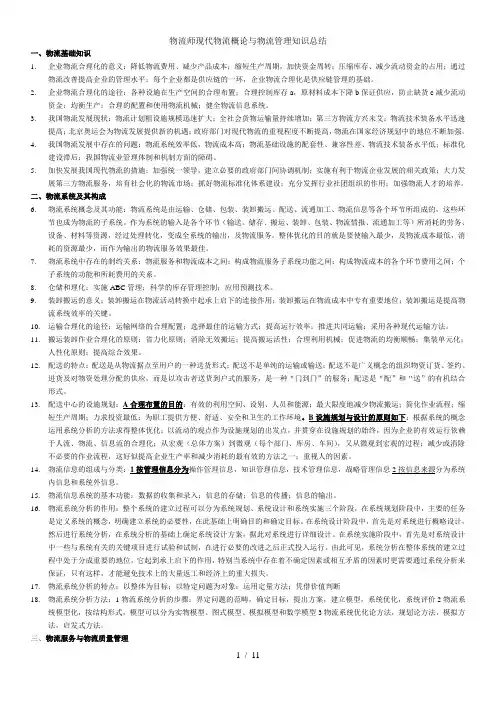
一、物流基础知识1.企业物流合理化的意义:降低物流费用、减少产品成本;缩短生产周期,加快资金周转;压缩库存、减少流动资金的占用;通过物流改善提高企业的管理水平;每个企业都是供应链的一环,企业物流合理化是供应链管理的基础。
2.企业物流合理化的途径:各种设施在生产空间的合理布置;合理控制库存a,原材料成本下降b保证供应,防止缺货c减少流动资金;均衡生产;合理的配置和使用物流机械;健全物流信息系统。
3.我国物流发展现状:物流计划粗设施规模迅速扩大;全社会货物运输量持续增加;第三方物流方兴未艾;物流技术装备水平迅速提高;北京奥运会为物流发展提供新的机遇;政府部门对现代物流的重视程度不断提高,物流在国家经济规划中的地位不断加强。
4.我国物流发展中存在的问题:物流系统效率低,物流成本高;物流基础设施的配套性、兼容性差、物流技术装备水平低;标准化建设滞后;我国物流业管理体制和机制方面的障碍。
5.加快发展我国现代物流的措施:加强统一领导,建立必要的政府部门间协调机制;实施有利于物流企业发展的相关政策;大力发展第三方物流服务,培育社会化的物流市场;抓好物流标准化体系建设;充分发挥行业社团组织的作用;加强物流人才的培养。
二、物流系统及其构成6.物流系统概念及其功能:物流系统是由运输、仓储、包装、装卸搬运、配送、流通加工、物流信息等各个环节所组成的,这些环节也成为物流的子系统。
作为系统的输入是各个环节(输送、储存、搬运、装卸、包装、物流情报、流通加工等)所消耗的劳务、设备、材料等资源,经过处理转化,变成全系统的输出,及物流服务。
整体优化的目的就是要使输入最少,及物流成本最低,消耗的资源最少,而作为输出的物流服务效果最佳。
7.物流系统中存在的制约关系:物流服务和物流成本之间;构成物流服务子系统功能之间;构成物流成本的各个环节费用之间;个子系统的功能和所耗费用的关系。
8.仓储和理化:实施ABC管理;科学的库存管理控制;应用预测技术。
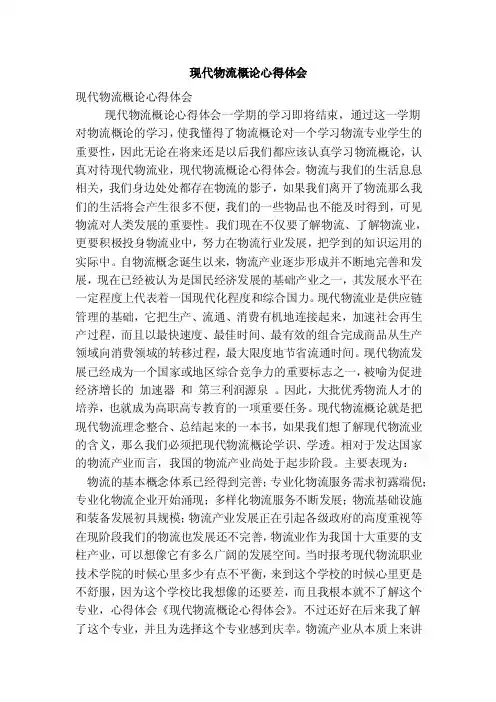
现代物流概论心得体会现代物流概论心得体会现代物流概论心得体会一学期的学习即将结束,通过这一学期对物流概论的学习,使我懂得了物流概论对一个学习物流专业学生的重要性,因此无论在将来还是以后我们都应该认真学习物流概论,认真对待现代物流业,现代物流概论心得体会。
物流与我们的生活息息相关,我们身边处处都存在物流的影子,如果我们离开了物流那么我们的生活将会产生很多不便,我们的一些物品也不能及时得到,可见物流对人类发展的重要性。
我们现在不仅要了解物流、了解物流业,更要积极投身物流业中,努力在物流行业发展,把学到的知识运用的实际中。
自物流概念诞生以来,物流产业逐步形成并不断地完善和发展,现在已经被认为是国民经济发展的基础产业之一,其发展水平在一定程度上代表着一国现代化程度和综合国力。
现代物流业是供应链管理的基础,它把生产、流通、消费有机地连接起来,加速社会再生产过程,而且以最快速度、最佳时间、最有效的组合完成商品从生产领域向消费领域的转移过程,最大限度地节省流通时间。
现代物流发展已经成为一个国家或地区综合竞争力的重要标志之一,被喻为促进经济增长的加速器和第三利润源泉。
因此,大批优秀物流人才的培养,也就成为高职高专教育的一项重要任务。
现代物流概论就是把现代物流理念整合、总结起来的一本书,如果我们想了解现代物流业的含义,那么我们必须把现代物流概论学识、学透。
相对于发达国家的物流产业而言,我国的物流产业尚处于起步阶段。
主要表现为:物流的基本概念体系已经得到完善;专业化物流服务需求初露端倪;专业化物流企业开始涌现;多样化物流服务不断发展;物流基础设施和装备发展初具规模;物流产业发展正在引起各级政府的高度重视等在现阶段我们的物流也发展还不完善,物流业作为我国十大重要的支柱产业,可以想像它有多么广阔的发展空间。
当时报考现代物流职业技术学院的时候心里多少有点不平衡,来到这个学校的时候心里更是不舒服,因为这个学校比我想像的还要差,而且我根本就不了解这个专业,心得体会《现代物流概论心得体会》。
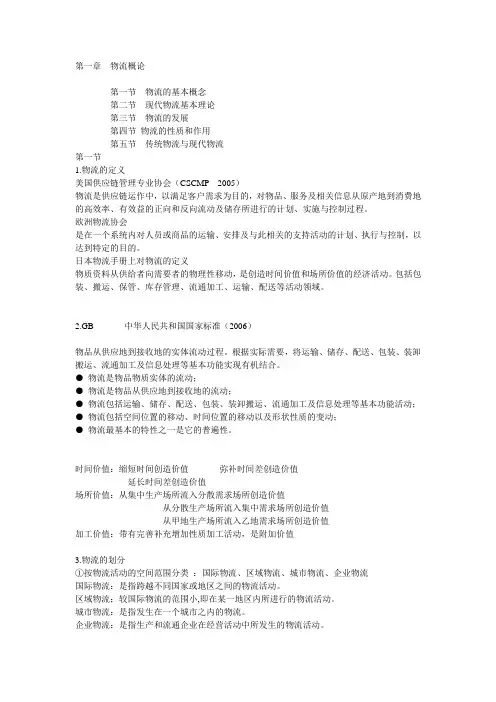
第一章物流概论第一节物流的基本概念第二节现代物流基本理论第三节物流的发展第四节物流的性质和作用第五节传统物流与现代物流第一节1.物流的定义美国供应链管理专业协会(CSCMP 2005)物流是供应链运作中,以满足客户需求为目的,对物品、服务及相关信息从原产地到消费地的高效率、有效益的正向和反向流动及储存所进行的计划、实施与控制过程。
欧洲物流协会是在一个系统内对人员或商品的运输、安排及与此相关的支持活动的计划、执行与控制,以达到特定的目的。
日本物流手册上对物流的定义物质资料从供给者向需要者的物理性移动,是创造时间价值和场所价值的经济活动。
包括包装、搬运、保管、库存管理、流通加工、运输、配送等活动领域。
2.GB 中华人民共和国国家标准(2006)物品从供应地到接收地的实体流动过程。
根据实际需要,将运输、储存、配送、包装、装卸搬运、流通加工及信息处理等基本功能实现有机结合。
●物流是物品物质实体的流动;●物流是物品从供应地到接收地的流动;●物流包括运输、储存、配送、包装、装卸搬运、流通加工及信息处理等基本功能活动;●物流包括空间位置的移动、时间位置的移动以及形状性质的变动;●物流最基本的特性之一是它的普遍性。
时间价值:缩短时间创造价值弥补时间差创造价值延长时间差创造价值场所价值:从集中生产场所流入分散需求场所创造价值从分散生产场所流入集中需求场所创造价值从甲地生产场所流入乙地需求场所创造价值加工价值:带有完善补充增加性质加工活动,是附加价值3.物流的划分①按物流活动的空间范围分类:国际物流、区域物流、城市物流、企业物流国际物流:是指跨越不同国家或地区之间的物流活动。
区域物流:较国际物流的范围小,即在某一地区内所进行的物流活动。
城市物流:是指发生在一个城市之内的物流。
企业物流:是指生产和流通企业在经营活动中所发生的物流活动。
②按物流活动的性质分类:供应物流、销售物流、生产物流、回收物流、废弃物流。
供应物流:是指提供原材料、零部件或其他物料时所发生的物流活动。
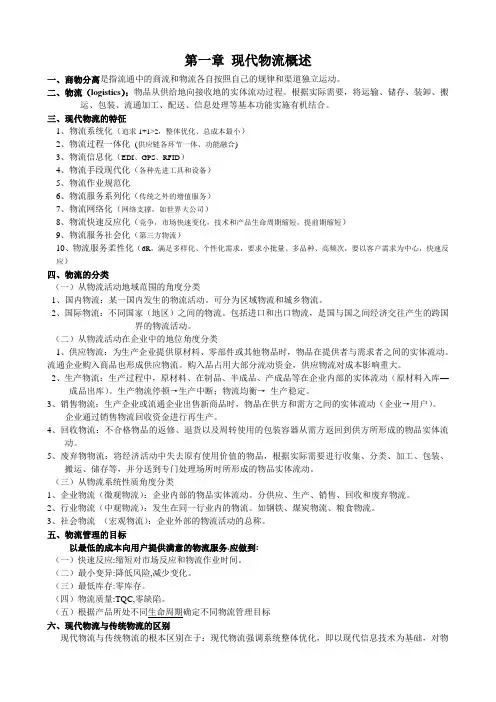
第一章现代物流概述一、商物分离是指流通中的商流和物流各自按照自己的规律和渠道独立运动。
二、物流(logistics):物品从供给地向接收地的实体流动过程。
根据实际需要,将运输、储存、装卸、搬运、包装、流通加工、配送、信息处理等基本功能实施有机结合。
三、现代物流的特征1、物流系统化(追求1+1>2,整体优化、总成本最小)2、物流过程一体化(供应链各环节一体、功能融合)3、物流信息化(EDI、GPS、RFID)4、物流手段现代化(各种先进工具和设备)5、物流作业规范化6、物流服务系列化(传统之外的增值服务)7、物流网络化(网络支撑,如世界大公司)8、物流快速反应化(竞争,市场快速变化,技术和产品生命周期缩短,提前期缩短)9、物流服务社会化(第三方物流)10、物流服务柔性化(6R,满足多样化、个性化需求,要求小批量、多品种、高频次,要以客户需求为中心,快速反应)四、物流的分类(一)从物流活动地域范围的角度分类1、国内物流:某一国内发生的物流活动。
可分为区域物流和城乡物流。
2、国际物流:不同国家(地区)之间的物流。
包括进口和出口物流,是国与国之间经济交往产生的跨国界的物流活动。
(二)从物流活动在企业中的地位角度分类1、供应物流:为生产企业提供原材料、零部件或其他物品时,物品在提供者与需求者之间的实体流动。
流通企业购入商品也形成供应物流。
购入品占用大部分流动资金,供应物流对成本影响重大。
2、生产物流:生产过程中,原材料、在制品、半成品、产成品等在企业内部的实体流动(原材料入库—成品出库)。
生产物流停顿→生产中断;物流均衡→生产稳定。
3、销售物流:生产企业或流通企业出售新商品时,物品在供方和需方之间的实体流动(企业→用户)。
企业通过销售物流回收资金进行再生产。
4、回收物流:不合格物品的返修、退货以及周转使用的包装容器从需方返回到供方所形成的物品实体流动。
5、废弃物物流:将经济活动中失去原有使用价值的物品,根据实际需要进行收集、分类、加工、包装、搬运、储存等,并分送到专门处理场所时所形成的物品实体流动。
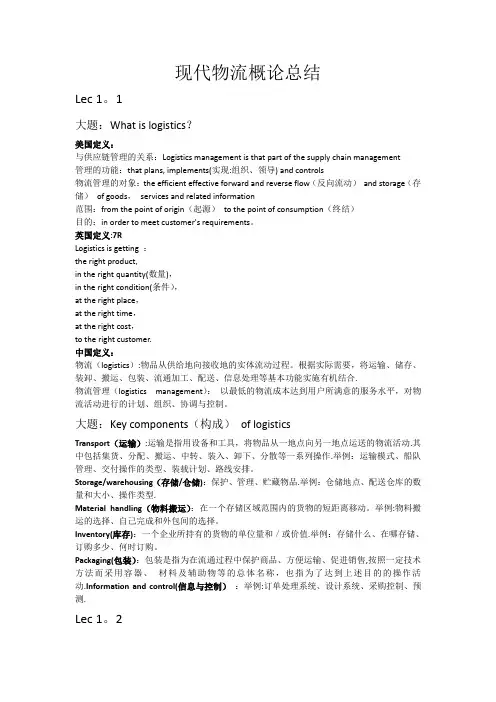
现代物流概论总结Lec 1。
1大题:What is logistics?美国定义:与供应链管理的关系:Logistics management is that part of the supply chain management管理的功能:that plans, implements(实现:组织、领导) and controls物流管理的对象:the efficient effective forward and reverse flow(反向流动)and storage(存储)of goods,services and related information范围:from the point of origin(起源)to the point of consumption(终结)目的:in order to meet customer's requirements。
英国定义:7RLogistics is getting :the right product,in the right quantity(数量),in the right condition(条件),at the right place,at the right time,at the right cost,to the right customer.中国定义:物流(logistics):物品从供给地向接收地的实体流动过程。
根据实际需要,将运输、储存、装卸、搬运、包装、流通加工、配送、信息处理等基本功能实施有机结合.物流管理(logistics management):以最低的物流成本达到用户所满意的服务水平,对物流活动进行的计划、组织、协调与控制。
大题:Key components(构成)of logisticsTransport(运输):运输是指用设备和工具,将物品从一地点向另一地点运送的物流活动.其中包括集货、分配、搬运、中转、装入、卸下、分散等一系列操作.举例:运输模式、船队管理、交付操作的类型、装载计划、路线安排。
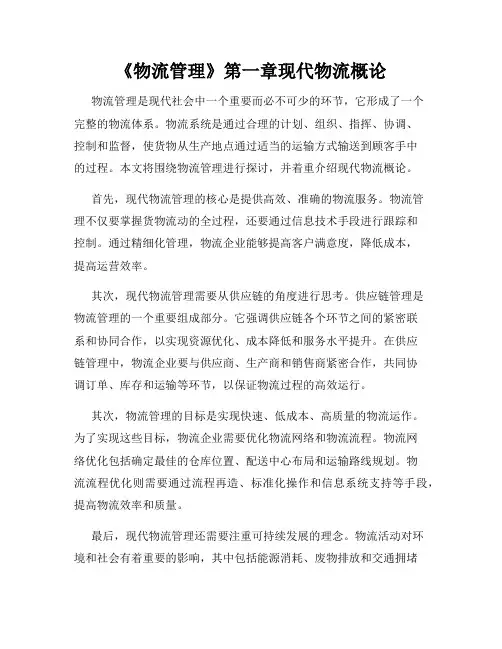
《物流管理》第一章现代物流概论物流管理是现代社会中一个重要而必不可少的环节,它形成了一个完整的物流体系。
物流系统是通过合理的计划、组织、指挥、协调、控制和监督,使货物从生产地点通过适当的运输方式输送到顾客手中的过程。
本文将围绕物流管理进行探讨,并着重介绍现代物流概论。
首先,现代物流管理的核心是提供高效、准确的物流服务。
物流管理不仅要掌握货物流动的全过程,还要通过信息技术手段进行跟踪和控制。
通过精细化管理,物流企业能够提高客户满意度,降低成本,提高运营效率。
其次,现代物流管理需要从供应链的角度进行思考。
供应链管理是物流管理的一个重要组成部分。
它强调供应链各个环节之间的紧密联系和协同合作,以实现资源优化、成本降低和服务水平提升。
在供应链管理中,物流企业要与供应商、生产商和销售商紧密合作,共同协调订单、库存和运输等环节,以保证物流过程的高效运行。
其次,物流管理的目标是实现快速、低成本、高质量的物流运作。
为了实现这些目标,物流企业需要优化物流网络和物流流程。
物流网络优化包括确定最佳的仓库位置、配送中心布局和运输路线规划。
物流流程优化则需要通过流程再造、标准化操作和信息系统支持等手段,提高物流效率和质量。
最后,现代物流管理还需要注重可持续发展的理念。
物流活动对环境和社会有着重要的影响,其中包括能源消耗、废物排放和交通拥堵等问题。
因此,物流企业需要通过引入绿色物流理念和环境管理体系,推广低碳运输方式和节能减排技术,减少物流活动对环境的不良影响。
在实施现代物流管理过程中,物流企业还需要充分利用信息技术的先进手段。
信息技术在现代物流管理中发挥着不可替代的作用。
通过信息系统的建设和运作,物流企业能够实现物流信息的集中管理和共享,提高物流信息处理的效率和准确性。
另外,物流企业还可以通过物联网技术,实现对物流设备和运输工具的远程监控和管理,提高物流安全和服务质量。
综上所述,物流管理是现代社会不可或缺的一个环节。
通过合理的计划、组织、指挥、协调、控制和监督,物流企业能够提供高效、准确的物流服务,实现供应链优化和物流流程的优化,同时实现快速、低成本、高质量的物流运作。
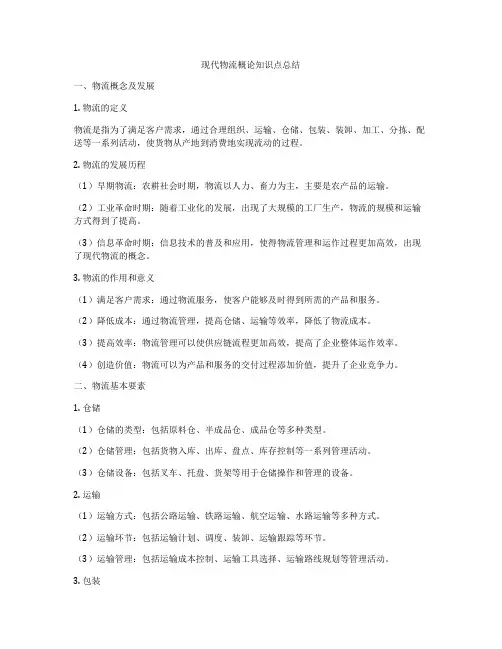
现代物流概论知识点总结一、物流概念及发展1. 物流的定义物流是指为了满足客户需求,通过合理组织、运输、仓储、包装、装卸、加工、分拣、配送等一系列活动,使货物从产地到消费地实现流动的过程。
2. 物流的发展历程(1)早期物流:农耕社会时期,物流以人力、畜力为主,主要是农产品的运输。
(2)工业革命时期:随着工业化的发展,出现了大规模的工厂生产,物流的规模和运输方式得到了提高。
(3)信息革命时期:信息技术的普及和应用,使得物流管理和运作过程更加高效,出现了现代物流的概念。
3. 物流的作用和意义(1)满足客户需求:通过物流服务,使客户能够及时得到所需的产品和服务。
(2)降低成本:通过物流管理,提高仓储、运输等效率,降低了物流成本。
(3)提高效率:物流管理可以使供应链流程更加高效,提高了企业整体运作效率。
(4)创造价值:物流可以为产品和服务的交付过程添加价值,提升了企业竞争力。
二、物流基本要素1. 仓储(1)仓储的类型:包括原料仓、半成品仓、成品仓等多种类型。
(2)仓储管理:包括货物入库、出库、盘点、库存控制等一系列管理活动。
(3)仓储设备:包括叉车、托盘、货架等用于仓储操作和管理的设备。
2. 运输(1)运输方式:包括公路运输、铁路运输、航空运输、水路运输等多种方式。
(2)运输环节:包括运输计划、调度、装卸、运输跟踪等环节。
(3)运输管理:包括运输成本控制、运输工具选择、运输路线规划等管理活动。
3. 包装(1)包装的作用:保护产品、便于搬运、便于堆放、传递信息等。
(2)包装材料:包括纸箱、塑料袋、木箱等多种包装材料。
(3)包装标准:包括包装尺寸、标签、印刷等一系列标准化要求。
4. 信息流(1)信息流的内容:包括订单信息、库存信息、运输信息等。
(2)信息流管理:包括信息采集、传输、处理、分析等一系列管理活动。
(3)信息流技术:包括物流信息系统、GPS定位、条码识别等技术的应用。
三、物流管理1. 物流成本管理(1)仓储成本:包括库存成本、仓储设备成本、仓储人力成本等。
![现代物流总结[5篇模版]](https://uimg.taocdn.com/d0ba17f4cf2f0066f5335a8102d276a2002960b5.webp)
现代物流总结[5篇模版]第一篇:现代物流总结现代物流稳定型与动态性供应链(相对稳定、单一市场;变化频繁、多个市场)平衡型与倾斜型供应链(容量、需求量)保险储备量是为了应付意外事件的发生而准备的。
当缺货成本远远大于所需要的库存成本时,企业需要保险储备,反之,企业不需要订购点法-是通过确定订购点而确定订购时间的方法,订货点是指提出订货时的库存量标准(或水平)。
订购点=备运时间需要量(经常储备量)+保险储备量备运时间也称前置时间,是指从提出订购至商品到达所需要的时间。
一般包括订购时间、发货时间、运输时间和验收时间等。
需求量已知并且稳定不变,库存量随着时间均匀连续地下降库存补充的过程可以在瞬间完成,即不存在一边进货一边消耗的问题产品的单位价格为常数,不存在批量优惠储存费用以平均库存为基础进行计算每次的订货成本及订货提前期均为常数对产品的任何需求都将及时得到满足,不存在缺货方面的问题定期订购是指订购时间或者订购周期确定,而订购批量不确定的一种订购形式。
配货作业方法拣选方式-也称摘取方式,是在配送中心和仓库分别为每个用户拣选其所需要货物。
(适合业务量小)分货方式-也称播种方式,是将需要配送的同一种货物,从配送中心或仓库搬运到发货场地,然后再根据各用户对该种货物的需求量进行二次分配。
(适合业务量大)二者的比较物流中心是从事物流活动的、具有完善的信息网络的场所或组织,应符合下列要求:主要面向社会服务;物流功能健全;完善的信息网络;辐射范围大;少品种、大批量;存储、吞吐能力强;物流业务统一经营管理。
物流园区与物流中心和配送中心的区别P.152它们是出于不同层次的物流节点物流园区是多种运输方式的交汇点在规模、功能、辐射范围、资源整合以及对经济发展的贡献方面,物流园区最大,物流中心次之,配送中心则较小。
控制城市固体废弃物产生量增长的措施逐步改变燃料结构;净菜进城、减少垃圾产生量;避免过度包装和减少一次性商品的使用;加强产品的生态设计;推行垃圾分类收集;搞好产品回收、利用的再循环城市生活垃圾分类收集的环境和社会效益实施城市生活垃圾分类收集使垃圾减量,也就是污染物减量;将有毒有害垃圾分离出来有利于垃圾无害化处理,使水污染风险减小;生活垃圾分类收集需要全体居民的参与和全社会的关注,有利于提高城市居民的环卫意识。
现代物流概论总结Lec大题:What is logistics美国定义:与供应链管理的关系:Logistics management is that part of the supply chain management 管理的功能:that plans, implements(实现:组织、领导) and controls物流管理的对象:the efficient effective forward and reverse flow(反向流动) and storage(存储) of goods, services and related information范围:from the point of origin(起源) to the point of consumption(终结)目的:in order to meet customer’s requirements.英国定义:7RLogistics is getting :the right product,in the right quantity(数量),in the right condition(条件),at the right place,at the right time,at the right cost,to the right customer。
中国定义:物流(logistics):物品从供给地向接收地的实体流动过程。
根据实际需要,将运输、储存、装卸、搬运、包装、流通加工、配送、信息处理等基本功能实施有机结合。
物流管理(logistics management):以最低的物流成本达到用户所满意的服务水平,对物流活动进行的计划、组织、协调与控制。
大题:Key components(构成) of logisticsTransport(运输):运输是指用设备和工具,将物品从一地点向另一地点运送的物流活动。
其中包括集货、分配、搬运、中转、装入、卸下、分散等一系列操作。
一、物流的定义、分类、功能1.定义:物流是供应链活动运作中,以满足客户要求为目的,对商品、服务及相关信息从产地到消费地之间实现高效率和低成本的正向和反向的流动和储存而进行的规划、实施、控制过程。
2.物流的基本职能:需求预测、订单处理、客户服务、分销配送、物料采购、存货控制、运输、仓库管理、工业包装、物资搬运、工厂和仓库或配送中心的选址、零配件和技术服务支持、退货处理、废弃物和废弃产品的回收处理等,以及与上述职能相关的情报信息等。
二、物流中心的定义、分类、功能1.定义:从事物流活动的场所或组织,应基本符合下列要求:主要面向社会服务;物流功能健全;完善的信息网络;辐射范围大;少品种、大批量;存储、吞吐能力强;物流业务统一经营、管理2.分类:1)根据商品流通的阶段划分位于生产地附近属于制造商的物资调达或产品存放的物流中心;处于生产地与消费地之间,属于广域厂商或批发商的流通中心;位于消费地附近,隶属于批发商或零售商的旨在为零售店铺服务的商品中心;面向不特定多数消费者,从事商品配送功能的配送中心;2)根据运营主体划分厂商运营的物流中心;批发商运营的物流中心;零售商运营的物流中心;第三方运营的物流中心;3)根据功能划分转运型物流中心;储存型物流中心;流通型物流中心;综合性物流中心;3.功能:衔接功能;信息功能;管理功能;三、配送中心的定义、分类、功能1.定义:从事配送业务的物流场所或组织,应基本符合下列要求:主要为特定的用户服务;配送功能健全;完善的信息网络;辐射范围小;多品种、小批量;以配送为主,储存为辅。
2.分类:按配送中心的经济功能分类1)供应配送中心2)销售配送中心3)储存型配送中心4)流通型配送中心5)加工配送中心3.功能:1)储存功能。
2)集散功能。
3)分拣、理货功能。
4)加工功能。
5)衔接功能。
6)信息功能。
四、物流园区的定义、分类、功能1.定义:物流园区是指在城市周围集中建设的配送中心、货物中转站、仓库园区、批发园区以及流通加工厂等与流通相关的设施群。
《现代物流概论》的心得体会——物流中的利润第一篇:《现代物流概论》的心得体会——物流中的利润《现代物流概论》的心得体会——物流中的利润利润,企业成立最初的追求,目标;企业想要发展壮大的源泉;企业承担社会责任的资本。
所以,一个企业想要获得真正意义上的成功,一个良好的盈利模式将是必不可少的条件。
由于我想将从事物流行业作为我将来的职业,在加上通过本学期我们尊敬的袁云斌老师的谆谆教导,我对物流的有哪些利润点,如何盈利,有了更深刻的认识,与了解。
在我来到“湖南现代物流职业技术学院”之前,我所知道的利润点就只有两点:1.用车给客户拉货,收取佣金。
2.为客户提供储存货物之便,收取一定的费用。
那时的我就在想如果是一个大型的物流企业的话,他单靠这两项业务能运营得起它这么大的开支吗?如果有一天它的竞争者将这两项业务中的任何一项业务的市场价格降低,那它好不就要出现很大的亏损了;还有就是那么多的物流企业都只做这两项业务那它们应该无法生存下去啊?那时的我对物流是“六窍通了通了五窍———那时一窍不通啊!”带着这些疑问,和一些其他的原因我来到了“湖南现代物流职业技术学院”,开始我的大学生活,和追求知识和完善人生的道路。
很幸运的是,缘分使我选择了袁老师的《现代物流概论》课,在他这一学期的谆谆教导中,我开始找到了我的答案,同时也是我在上完这一学期的《现代物流概论》后的一些心得与收获。
物流,什么是物流?以前的我根本不知道。
现在的我加上我以往的对物流认识的经验,在中国,美国,欧洲,日本的物流定义中,我会选择美国在1998年对物流的新定义:“物流是供应链运作中,以满足客户要求为目的,对货物,服务和相关信息在产出地和消费者之间实现高效率低成本的正向和反向的流动和储存所进行的计划,执行和控制过程。
”我很赞成它将物流看做是一条供应链。
因为物流行业明明就是服务行业的一个分支,也就是说物流是服务于其他企业的,不仅有传统的制造型企业,而且还有像电子商务这类的新兴企业,美国将它看做供应链的同时也是将它和其他企业的距离拉近了。
《现代物流概论》一、引言现代物流在当今社会已经成为一个重要而不可或缺的行业,它不仅能够为人们的生活提供便利,还能有效地推动经济的发展。
本文将从物流的概念和特点、物流体系以及物流管理等方面介绍现代物流的基本知识。
二、物流的概念和特点物流是指在成本和服务水平要求的前提下,通过一系列的物流活动,将生产和消费之间的物理运动,以及相应的信息和资金流动,协调安排起来,满足社会经济发展和人民生活的需要。
物流具有以下几个特点:1.多元化:物流活动涉及到货物、信息和资金等多个方面的流动。
2.过程性:物流是一个包含多个环节和流程的系统,需要对每个环节进行有效管理。
3.综合性:物流不仅涉及到生产和物流企业的合作,还涉及到商家、运输公司等多个利益相关方之间的合作。
4.时效性:物流需要在一定的时间内将货物从生产地点送达客户,需要高效的时间管理和运输调度。
5.可视性:物流需要对货物的位置和状态进行实时监控,以保证货物的安全和有效运输。
三、物流体系物流体系是指在特定的空间范围内,通过一系列的组织机构和设备设施,利用物流技术和信息系统,进行物流活动的一个完整的系统。
物流体系可以分为供应链管理、仓储管理、运输管理和信息管理等几个部分。
1.供应链管理:供应链管理是通过对供应商、生产商、分销商和零售商等各个环节进行协调和合作,以实现生产和销售之间的无缝对接。
供应链管理可以提高物流的效益和效率,降低物流的成本,提供更好的服务。
2.仓储管理:仓储管理是指对货物进行储存和保管的一系列活动。
合理的仓储管理可以有效地降低物流成本,提高货物的利用率和周转率。
3.运输管理:运输管理是指对货物进行运输的管理活动。
运输管理包括运输方式的选择、路线的规划、运输工具的调度等。
合理的运输管理可以降低物流的运输成本,提高运输的效率。
4.信息管理:信息管理是指通过信息系统对物流活动进行有效管理和控制。
信息管理可以提高物流的可视性、时效性和管理效率。
四、物流管理物流管理是指对物流活动进行计划、组织、实施和控制的过程。
现代物流概论一、物流的基本概念、定义和分类(一)物流基本概念1、商流。
对象物所有权转移的活动称为商流。
商流体现的是买与卖的关系,是物质资料的所有权转移,创造所有权价值,是一种非物理性的移动。
2、物流。
物流是指物质资料的实体从供给方向需求方转移,实现其使用价值。
物流活动是创造空间效益和时间效益的活动,是一种物理性移动。
物流中的“物”泛指一切运动形态物质资料,有物资、物料、货物、商品、物品的含义。
物流中的“流”泛指一切有移动、运动、流动的含义。
物流的运输功能产生空间效应,而物流的储存功能产生时间效应。
3、商流和物流的关系。
商流和物流都是流通的组成部分,物流是产生商流的物质基础,商流是产生物流的前提条件,商流和物流总是相伴发生的。
4、商物分离(1)商物分离的概念。
商流和物流各自具有不同的活动内容和规律。
商流一般要经过一定的经营环节来进行业务活动;而物流则不受经营环节的限制,使商品尽可能由产地通过最少环节,以最短的物流路线,按时保质地送到用户手中,以达到降低物流费用、提高经济效益的目的。
(2)商物分离的特点和优点。
特点是:保管,由配送中心集中保管取代分散保管;输送,由工厂仓库至配送中心再送至零售店的两段运输取代三段或多段运输;配送,由回路配送取代分别分散配送;信息系统,以信息中心集中处理方式,用现代化通讯系统进行各环节的控制。
优点是:便于批量送货,便于采用机械化、自动化的保管设施和机械作业;有利于回路配送,提高运输设备利用率,降低流通费用,提高服务质量;可以使各部门的职能单纯化,提高工作效率。
(3)商物分离的表现形式①购销方式引起的商物分离形式。
主要是商物在时间上的分离,有预购、赊销和分期付款三种形式。
预购是商流在前、物流在后的商物分离形式。
赊销和分期付款是物流在先、商流在后的商物分离形式。
②结算程序引起的商物分离形式。
③期货市场形成的商物分离形式。
买卖双方在实物交割前进行的合约买卖是只有商流没有物流的行为,只有当实物交割时才发生物流行为,商流在前、物流在后。
现代物流概论知识点第一章物流基础知识定义:商流——对象物所有权转移的活动称为商流。
商流活动一般称为贸易或交易。
物流——物品从供应地向接受地的实体流动过程。
根据实际需要,将运输、仓储、装卸搬运、包装、流通加工、配送、信息处理等基本功能实施有机结合。
供应物流——生产企业、流通企业或消费者购入原材料、零部件或商品的物流过程称为供应物流。
销售物流——生产企业、流通企业售出产品或商品的物流过程称为销售物流。
生产物流——从工厂的原材料购进入库起,直到工厂成品库的成品发送为止,这一全过程的物流活动称为生产物流。
回收物流——在生产及流通活动中对一些资材进行回收并加以利用的物流活动称为回收物流。
废弃物物流——对生产和流通过程中所产生的无用废弃物的处理过程的物流活动称为废弃物物流。
社会物流——一般指流通领域所发生的物流,是全社会物流的整体,因此又称之为大物流或宏观物流。
它的一个标志是:它是伴随商业活动(贸易)发生的,也就是说物流过程和所有权的更迭是相关的。
企业物流——在企业经营围由生产或服务活动所形成的物流系统称为企业物流。
商物分离的概念:由于它们各自具有不同的活动容和规律,因此在经济活动中,进行商品交易活动的地点并不一定是商品实物流通的最佳路线必经之处。
商流一般要经过一定的经营环节来进行业务活动,而物流则不受经营环节的限制,根据商品的种类、数量、交货要求、运输条件等,以最短的物流路线,按时保质地送到用户手中实现商物分离的原则是提高社会经济效益的客观需要,也是企业现代化发展的需要。
两大关系:商流与物流商流和物流都是流通的组成部分,两者结合才能有效地实现商品由供方向需方的转移过程。
物流是产生商流的物质基础,在交易实施的步骤上商流是物流的先导,从全局来看商流和物流总是相伴发生的。
物流与生产加工活动和物流活动是生产系统的两个支柱。
物流为生产的连续性提供了保障。
生产系统必须向物流要效益才能改善自身的发展条件。
物流状况对生产环境和生产秩序起着决定性的作用。
现代物流概论总结Lec 1、1大题:What is logistics?美国定义:与供应链管理的关系:Logistics management is that part of the supply chain management管理的功能:that plans, implements(实现:组织、领导) and controls物流管理的对象:the efficient effective forward and reverse flow(反向流动) and storage(存储) of goods, services and related information范围:from the point of origin(起源) to the point of consumption(终结)目的:in order to meet customer’s requirements、英国定义:7RLogistics is getting :the right product,in the right quantity(数量),in the right condition(条件),at the right place,at the right time,at the right cost,to the right customer。
中国定义:物流(logistics):物品从供给地向接收地的实体流动过程。
根据实际需要,将运输、储存、装卸、搬运、包装、流通加工、配送、信息处理等基本功能实施有机结合。
物流管理(logistics management): 以最低的物流成本达到用户所满意的服务水平,对物流活动进行的计划、组织、协调与控制。
大题:Key components(构成) of logisticsTransport(运输):运输就是指用设备与工具,将物品从一地点向另一地点运送的物流活动。
其中包括集货、分配、搬运、中转、装入、卸下、分散等一系列操作。
举例:运输模式、船队管理、交付操作的类型、装载计划、路线安排。
Storage/warehousing(存储/仓储):保护、管理、贮藏物品。
举例:仓储地点、配送仓库的数量与大小、操作类型。
Material handling(物料搬运):在一个存储区域范围内的货物的短距离移动。
举例:物料搬运的选择、自己完成与外包间的选择。
Inventory(库存):一个企业所持有的货物的单位量与/或价值。
举例:存储什么、在哪存储、订购多少、何时订购。
Packaging(包装):包装就是指为在流通过程中保护商品、方便运输、促进销售,按照一定技术方法而采用容器、材料及辅助物等的总体名称,也指为了达到上述目的的操作活动。
Information and control(信息与控制) :举例:订单处理系统、设计系统、采购控制、预测。
Lec 1、2小题:When was physical distribution substituted by logistics formally in the western world?(在西方世界传统物流正式被现代物流所取代就是什么时候?) In 1980s、小题:When was logistics introduced in Japan? 二战后50s。
小题:When was logistics introduced in China? 90s、小题:Logistics and physical distribution?(现代物流与传统的关系就是什么样的?) 现代物流包含传统物流。
Lec 1、3小题:Logistics is the links among different enterprises and industries in the economy system、(物流就是经济系统中联系企业与制造业的存在)Logistics cost is one significant element of social total cost、(物流成本就是社会总成本中一个重要的元素)Logistics cost as a percentage of GDP to measure the rate of economy growth、(物流成本在GDP中的占比可以衡量经济增长)大题:Value-Added Role of Logistics(物流的增值角色)Form utility (what)形式效用:Refers to the value added to goods through(指的就是商品价值的增加)、举例:manufacturing /production or assemble process(制造业产品的组装过程)Place utility (where)空间效用:A value that logistics creates in a product by changing the product's location(物品地点的转移创造价值)、举例:Transportation creates place utility、Time utility (when)时间效用:A value created in a product by having the product available at the time desired(保证产品能够可靠的在一定时间内到达而产生价值)、举例:The transportation and warehousing create time utility、Quantity utility (how much)数量效用:Refers to delivering the proper quantities of an item to where it is demanded(指将适当数量的物品运送到需要的地方)、举例:Logistics creates quantity utility through production forecasting, production scheduling and inventory control、(物流通过产品预期,产品计划与库存控制的方式创造数量效用)Possession utility (why)占有效用:举例:The value created by mark eting’s effort to increase the desire to possesses a good or benefit from a service、(这种价值通过营销来增加对物品所有权与益处的服务而创造)小题:Effective logistics management can help business reduce cost so that it can provide cost advantage、(成本优势)Effective logistics management can help provide superior customer service so that this can enhance differentiation advantage (差异性优势)大题:Logistics interfaces in the firm(与企业其她部门的联系): Manufacturing, Marketing, Accounting、Logistics Interfaces with Operations/ Manufacturing:Length of production runs(生产运行时间的长短):Inventory cost(库存成本)Seasonal demand(季节需求):Acceptance of seasonal inventory to balance production times、(寻求季节性库存与产品供应的平衡)Supply-side interfaces:Stocking adequate supplies to ensure uninterrupted production、(储备充足的物资,保证不间断生产)Logistics Interfaces with Marketing:The Marketing Mix – 4 PsPrice、Product、Promotion(促销)、Place(渠道)Logistics Interfaces with accounting:ROA= gross profit /assetLec 1、4大题:What are company ’s competitive advantages?Superior product quality(优良的产品质量)Superior customer service(优良的客户服务)Wide distribution network(广泛的配送网络)Brand loyalty(品牌忠诚)Patents(专利)Superior management teamwork(优良的管理团队)Low cost plants(低成本工厂)Ownership of raw material supplies(原材料供应所有权)大题:Competitive Advantage-- Cost advantageAbsolute cost advantage(Lower costs than competition at all levels):(直接成本优势) Superior production technology(高级生产技术)、Low cost input supply(低成本投入供给)、Low cost operations(低成本运作)、Lower end-to-end delivered cost provided by logistics management(物流管理所提供的更低的终端到终端的交付费用)Relative cost advantage:(间接成本优势)Economic scale(经济规模)、Experience curve(经验曲线)能够带来的效果:Capacity utilization(能力利用率)、Schedule integration(计划整合)、Low waste(低浪费)、Low inventory(低库存)大题:Competitive Advantage-- DifferentiationProduct:Quality(质量)、Price、Performance(展示)、DesignService:Availability(可用性)、Pre-sale advice(售前咨询)、Finance(资金供给)、Delivery(配送)、Maintenance(维修)、After-sales service(售后服务)Marketing Intangibles:(营销型无形资产)Brand identity(品牌识别)、Brand image(品牌形象)、Reputation(信誉)、Corporate image(企业形象)能够带来的效果:Tailored service(订制服务)、Reliability(可靠性)、Information(信息)、Flexibility(灵活性)、Responsiveness(反应性)Lec 1、5小题:What is a system?系统就是由一组相互关联,功能相关的要素、变量、部件, 物体组成的统一整体、小题:What is Systems Concept?系统概念就是强调整体有效性而非强调系统的个体的有效性的一种决策方法、小题:Elements of Logistics System:流动要素7要素:流体、载体、流向、流量、流程、流速、流效小题:Cost PerspectiveThe most efficient systems are not always comprised of each system component operating at its lowest possible cost、(最有效的系统不总就是每个子系统操作成本最低的系统)The critical concern is to have the entire system operating at its lowest total cost、(关键就是要让着整个系统以最低的成本运作)大题:What is Optimization?(优化)The process of making something as good or as effective as possible with given resources and constraints(限制)、(在给定资源与约束条件下,使某物尽可能好的方法或尽可能有效的方法) 举例:delivery times(交货时间), minimum production capacity(最小生产能力), financial limits(金融限制)Level of Optimality:Within logistics components(物流组件内部)Between logistics components(物流组件之间)Between company functions(公司行为之间)Between the company and external organization(公司与外部组织之间)大题:Approaches to Analyzing Logistics SystemsMaterials Management v、Physical Distribution:材料管理与传统物流Material management (inbound logistics)输入物流:The movement and storage of materials from suppliers and vendors into production processes、(物料从供应商到生产过程的运动与储存) Physical distribution(outbound logistics)输出物流:The process related to the movement and storage of products from the end of the production line to the end user、(从生产线到终端用户的移动与存储产品的过程。